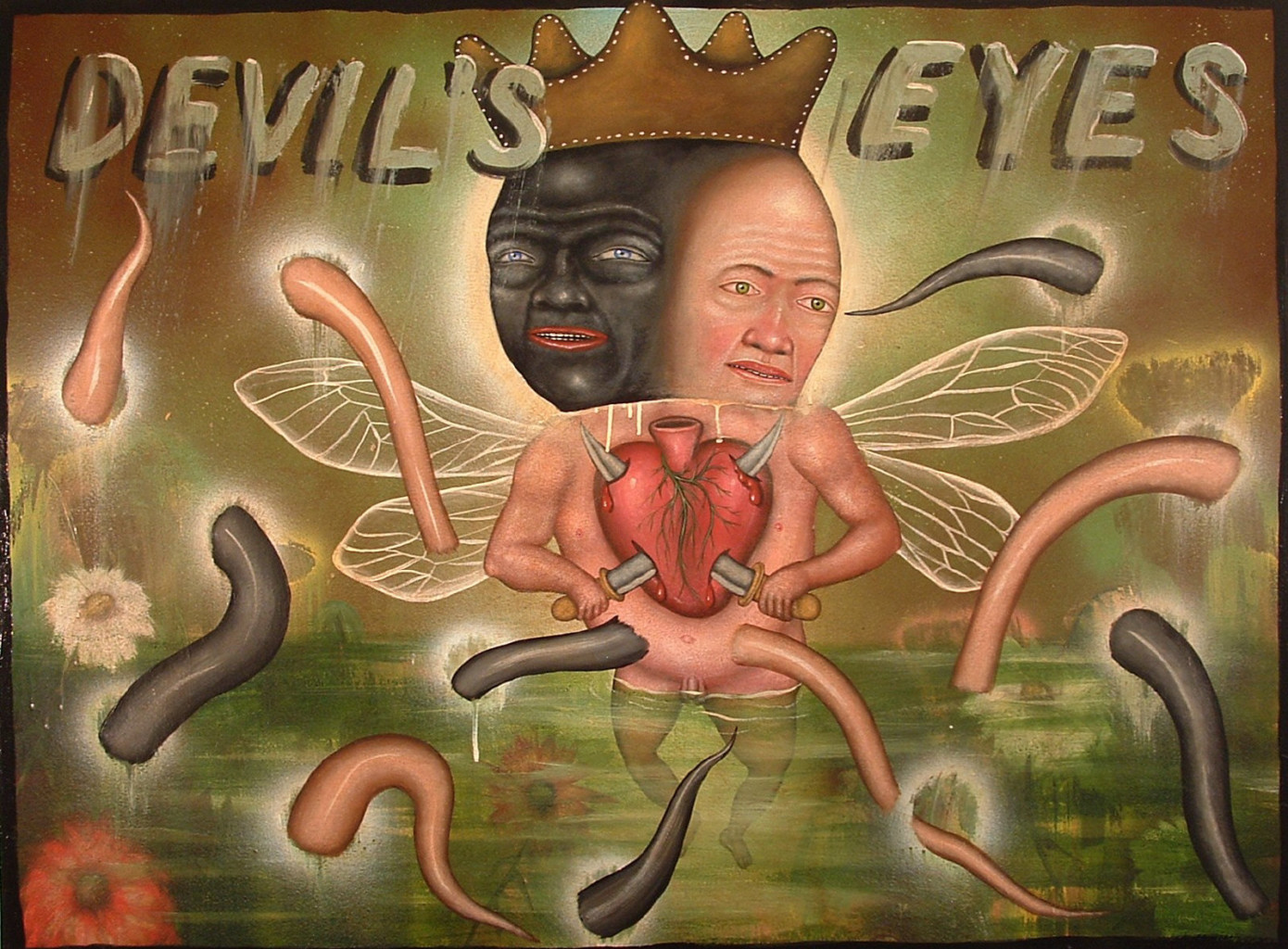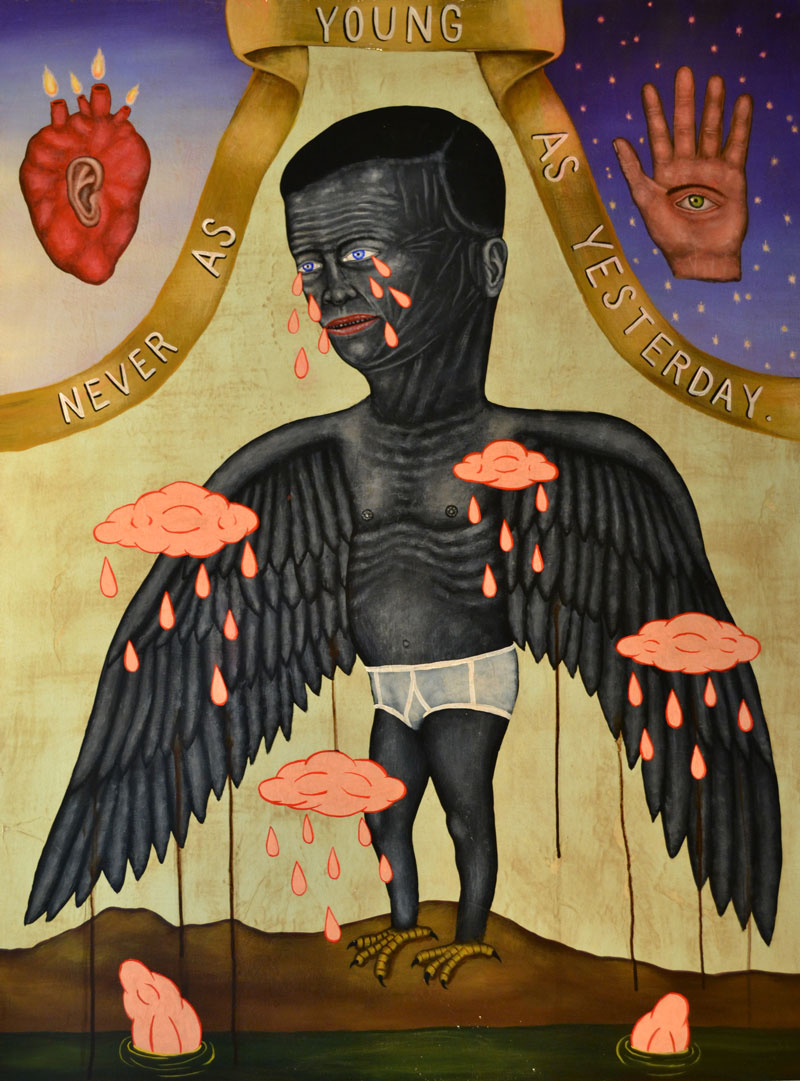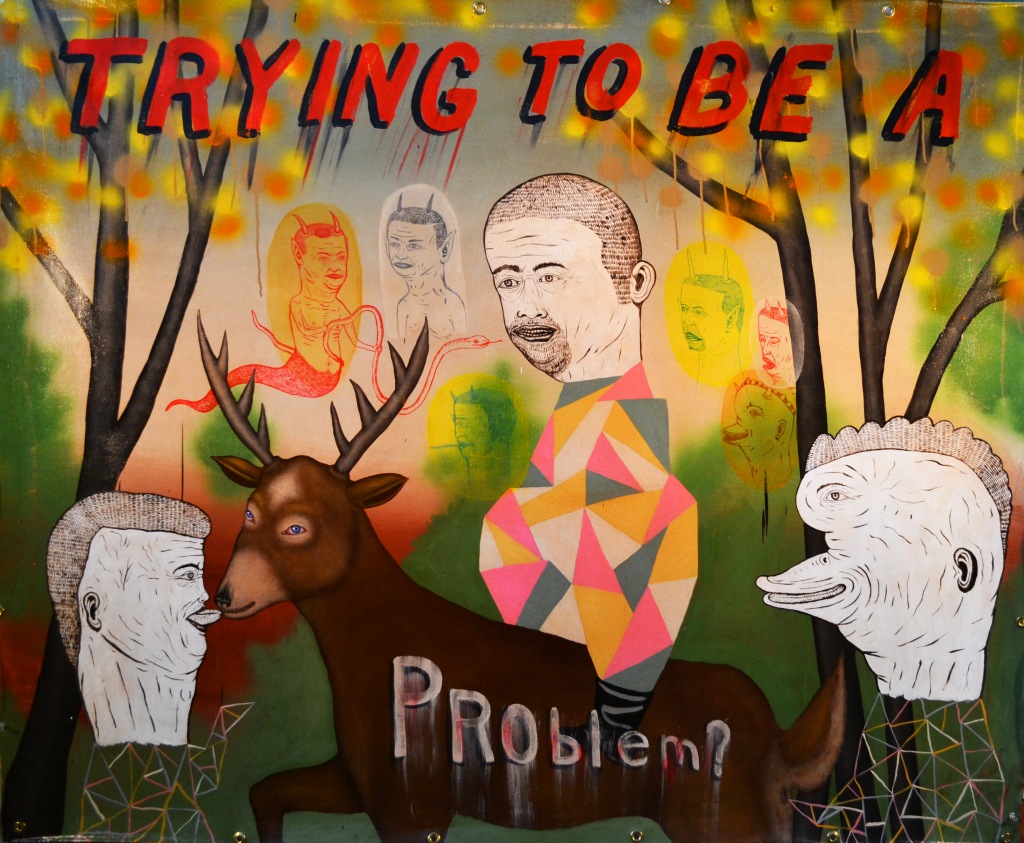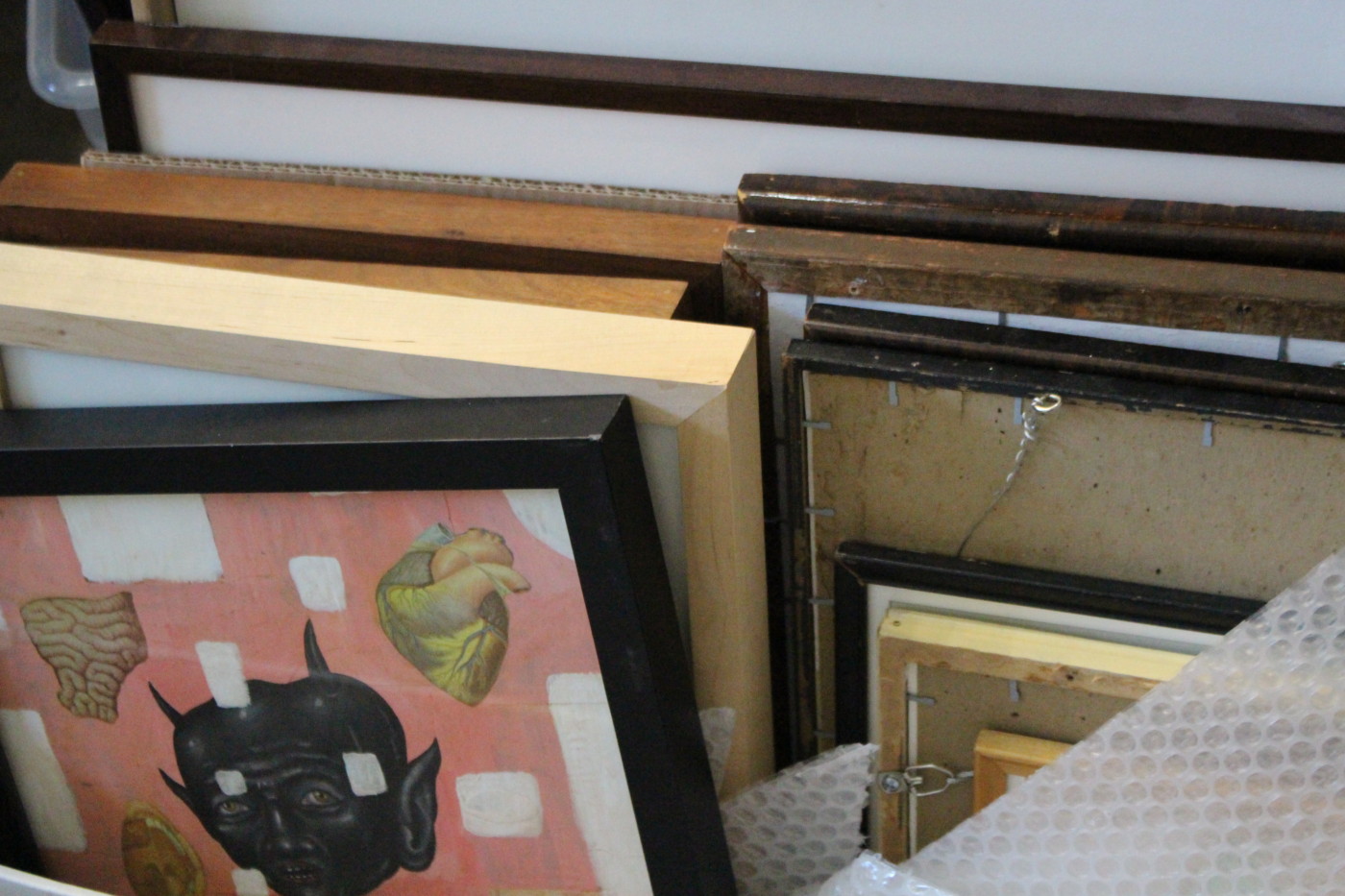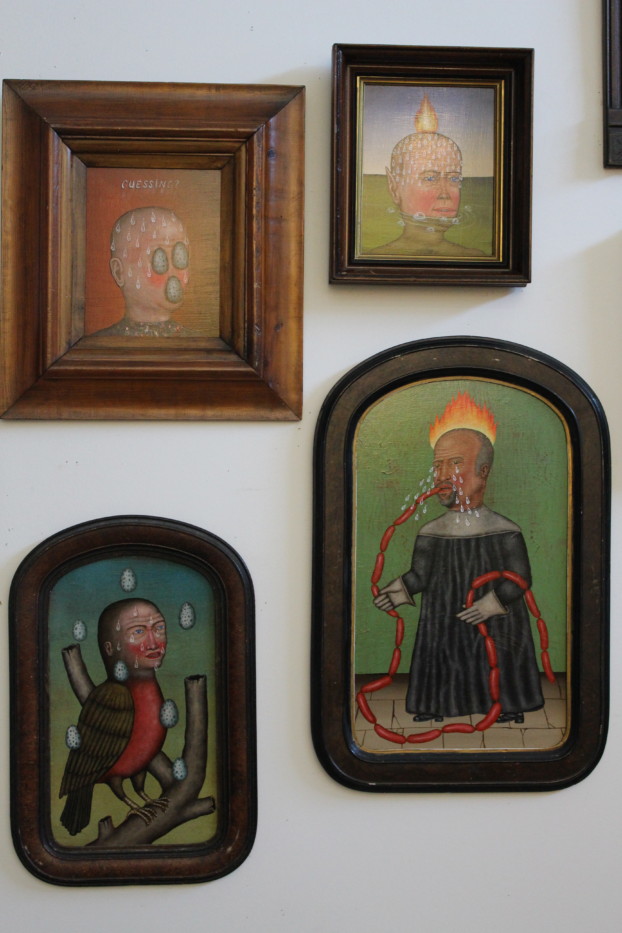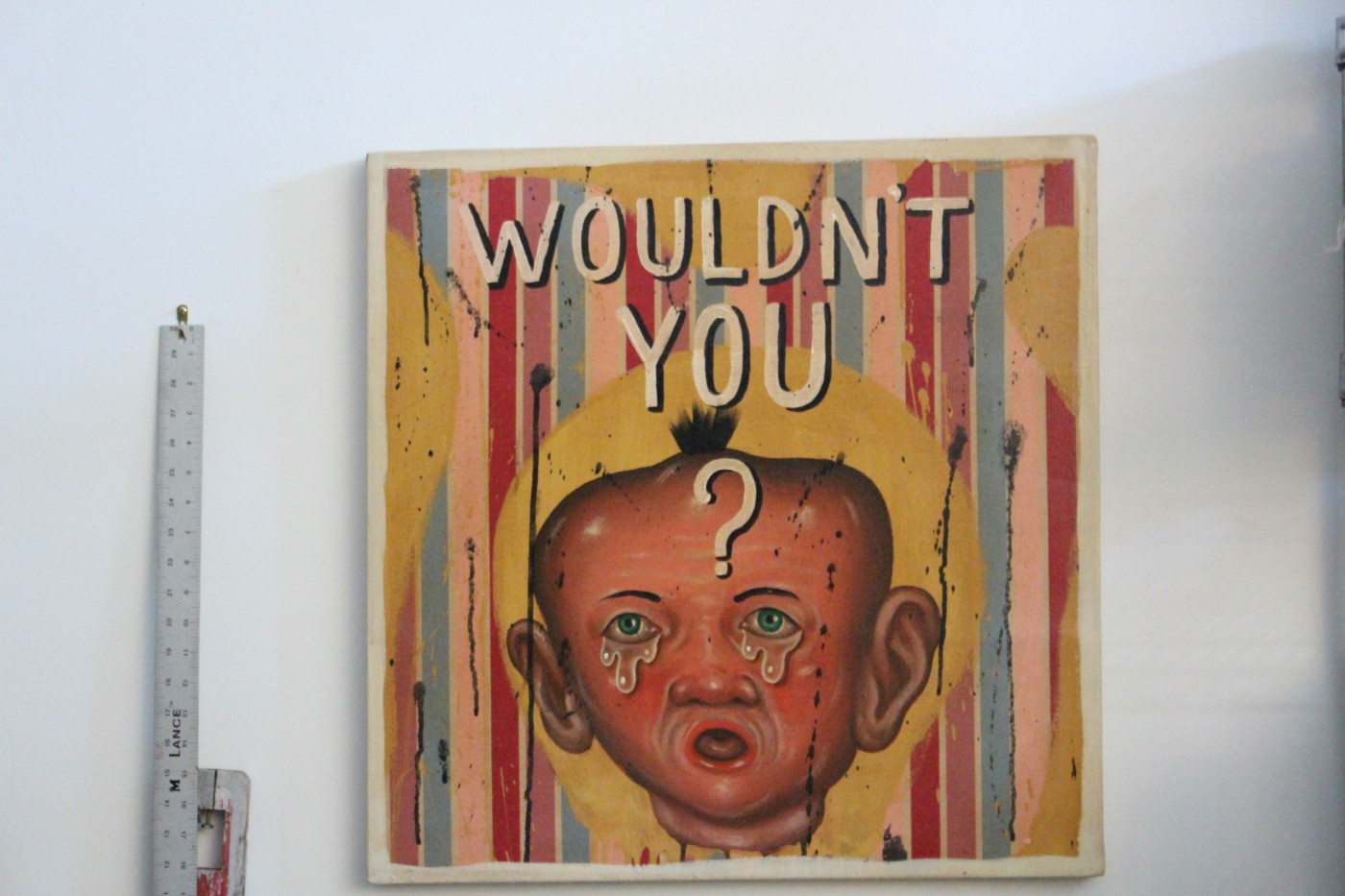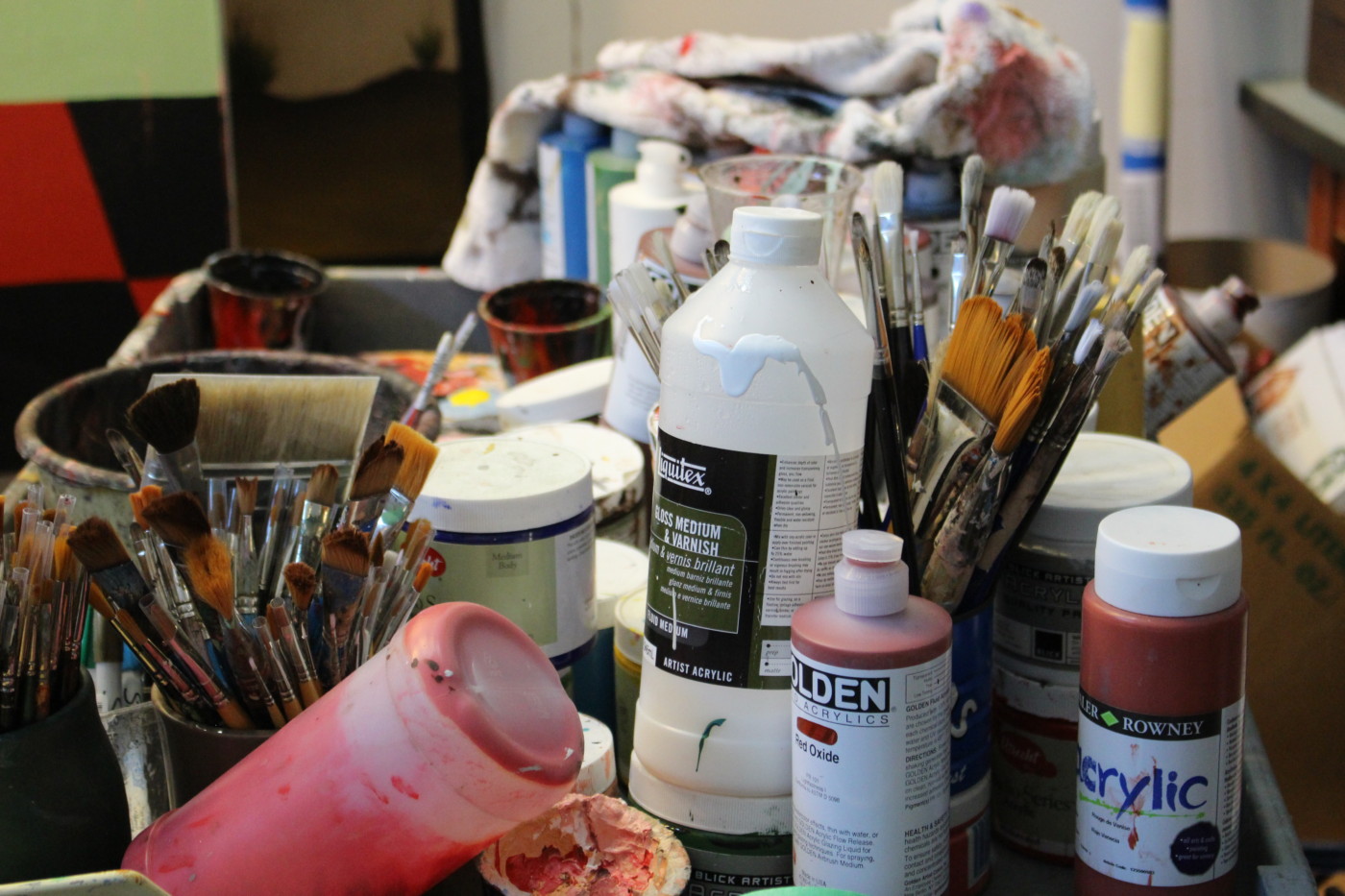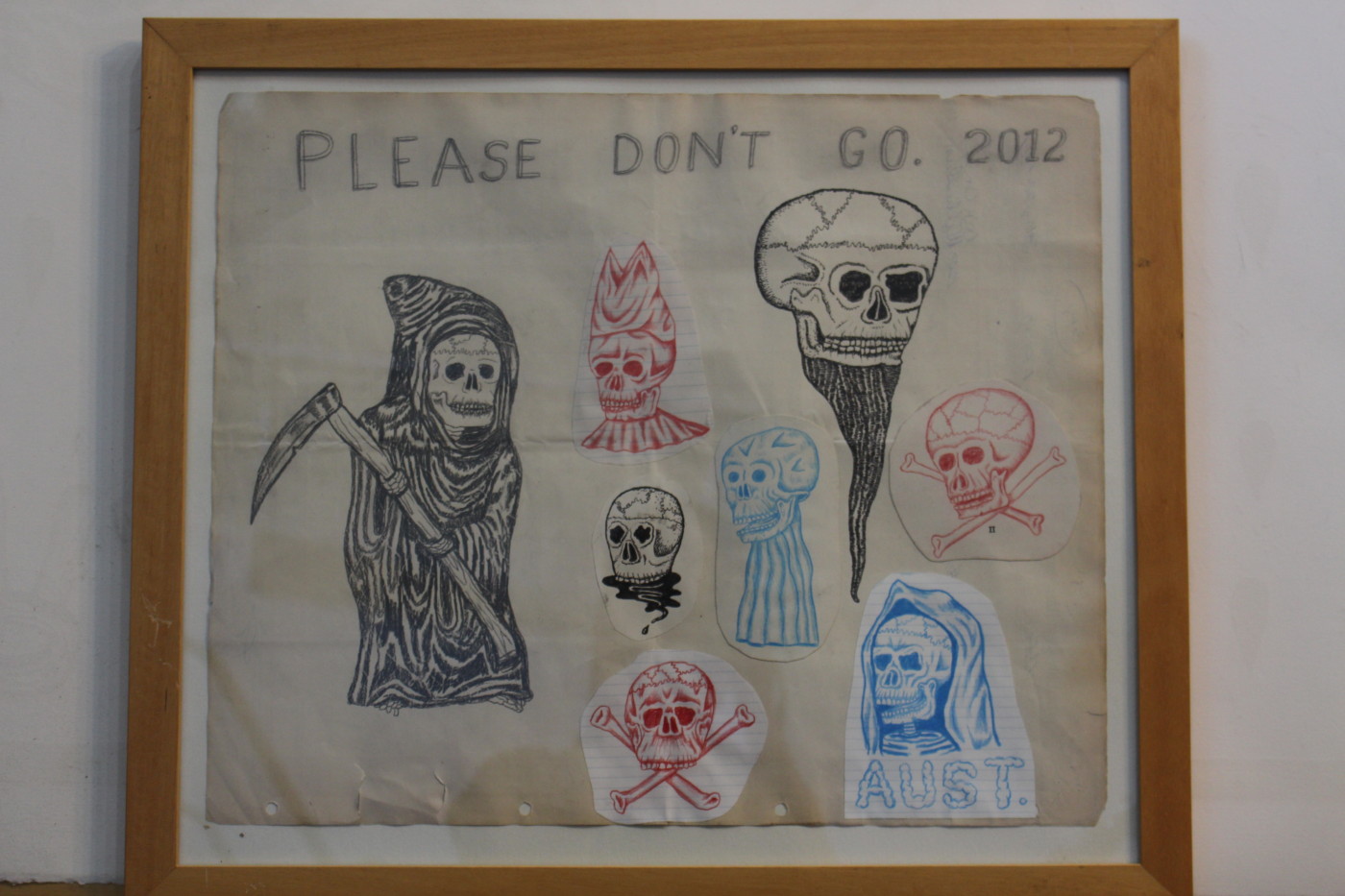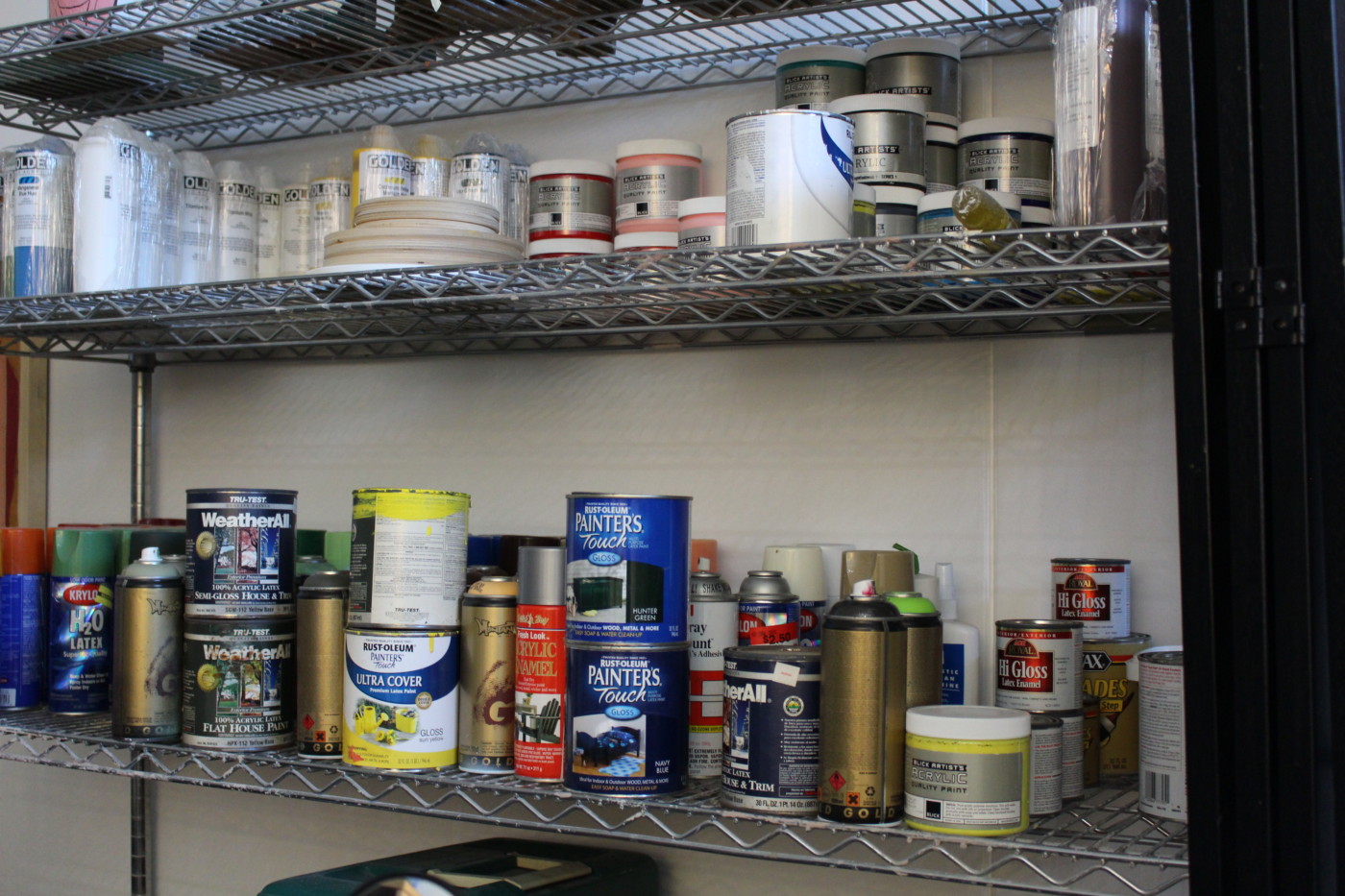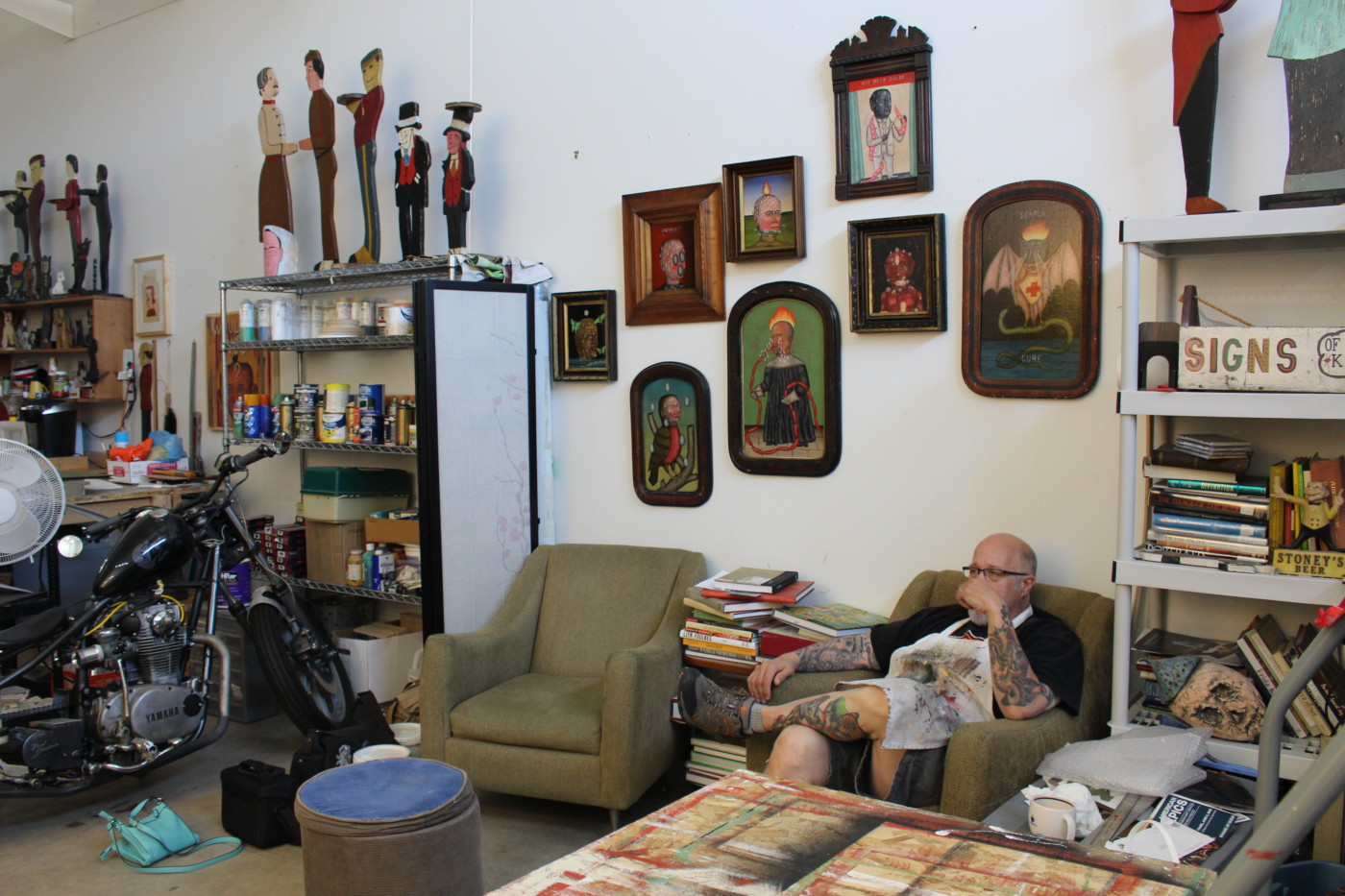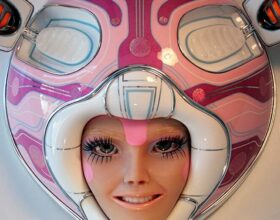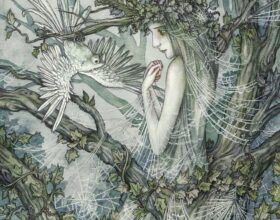Fred Stonehouse is a quintessential Wisconsin artist who has been navigating his way through the art scene since the early 1980’s. Starting from a humble beginning in Milwaukee, Fred has found a considerable amount of success in the United States and beyond. He has dedicated a lifetime to creating, building a life around being a maker, and devoting his time to visual storytelling. Beautiful.bizarre had the honor of visiting Fred at his studio in Madison, Wisconsin to discuss his life as a college professor, his artistic journey, and his many inspirations that contribute to his strangely alluring, delightfully surreal paintings.
As a kid who grew up on the north side of Milwaukee, in a rough neighborhood, the prospect of becoming who he is today was almost unimaginable. He studied auto mechanics in high school (Milwaukee Boys Technical High School) but found that the art room was where he really belonged. “I was just a gangster auto mechanic and to have this special little place in this tough high school to paint during lunch and study hall was life changing.” As a teenager, one could imagine the inner conflict Fred felt between what he was studying and what he really wanted to be doing art.
“I had this idea of how I needed to be perceived and it couldn’t be soft. But I loved making art, so there was this contradiction. I was super sensitive but I was also a hoodlum.”
Fred has a simple, refreshing view of himself as an artist- the money is barely a variable and the meaning is everything. He holds on tightly to the notion that artists are special beings who see and process the world differently than non-artists. He believes artists are more sensitized to their surroundings, allowing them to be perceptive in ways other people aren’t. He has a vision of the artist as a solitary being who pours themselves into their work, leaving nothing behind.
“Being in the studio and creating from your own imaginary world is special. That’s the reason I was willing to end up living under a bridge because that’s what I was after. It wasn’t about money. I’d be a security guard, a bouncer, or a mechanic to make money. Money is just a necessity, it is not meaning in your life. For me, if you took the meaning out of art, it’d be the same as anything else.”
After he graduated with his Bachelor of Fine Arts from the University of Wisconsin, Milwaukee, Fred first started showing in Chicago, Illinois at a huge art fair at Navy Pier. It was there that he found that people (important people connected with galleries) truly connected with his work and appreciated his oddball aesthetic. Eager to do shows and willing to do the hard work to make it as a professional artist, he gained exposure and branched out. Since Fred works primarily with acrylic paints, he has the ability to create prolific works in a timely manner. He usually works on pieces right up to the show and is glad he found a medium that suits that habit, especially since he has little patience for the drawn out drying process and toxicity of oil paint. Some of the work is rather primitively rendered and intentionally raw because Fred works from instinct, instead of from a place calling for fussy, refined perfectionism. He isn’t interested commercial slickness or seamlessness that is so popular in contemporary art currently.
“If a painting isn’t a little dirty and it isn’t growling at you from the wall a little bit, where you know it’s a physical thing, that’s a failure to me. That doesn’t mean it fails as an image, it fails as a painting to me. Where my paintings can still be sort of refined, there is still a physicality to them.”
Fred has cultivated a style that walks the line between zany and thoughtful, one that manages to delight the eyes while dealing with some serious content. “I used to say that the work is half joke, half prayer. I’m poking fun, but it’s also very serious.” These works will take viewers through a journey of fantastical imagery, giving light to characters that may seem a bit off, but are altogether vulnerable souls. If we look closely we can see mythology, cultural influences, and cryptic text (“I keep it ambiguous intentionally”). Hybrid creatures exist in fantastical, dreamlike worlds. Fiction and reality are intertwined, mixed up to the point where they are inseparable. Fred is interested in and inspired by a lot of things and that shows in his work.
He takes his role as a storyteller seriously, pulling inspiration from his own experiences, a variety of religious and symbolic imagery, and intricate human psychology. To fully understand, or even begin to understand, takes a bit of digging. But, the content is there and it is screaming to be heard. While there is a lot of humor and lightheartedness, there are some serious themes to grapple with. The outcome of his work is so unique and while it is seemingly visceral, it is so rich in substance while still being lighthearted in nature. It is interesting that Fred’s projected appearance itself even offers a beautiful contradiction- he is heavily tattooed with a sturdy stature but has a good-natured, pleasant, jolly demeanor and a refreshing sense of humor. His openness and willingness to share is a reflection of the underlying tenderness and vulnerability a lot of artists share. His figurative, surreal work stemmed from an early desire to create, a need for narrative, and to take memories, stories, religion, mythology, magic, dreams, and even politics and regurgitate them onto canvas. His stories are never specific, but always engaging. When it comes down to it, he is bringing in his own interests shaped by his view on the world.
He holds his philosophy of the artist as a ‘lonely archaeologist’ to a high esteem, not only preaching it but practicing it. “Art is for people who need to make things… that impulse to create from when they were four years old. People ask, ‘What does it mean to be a maker?’ It means you like to make sculpture, ceramics, and painting. It means you want to make things with your hands. That impulse is ancient. We’ve had that impulse from the beginning of history and it’s not going anywhere soon.” While the business of art is necessary for artists to exist and to thrive readily, the artist exists to foster conversation and remind audiences that everything is connected. It’s safe to say that Fred is a purest and traditionalist when it comes to the artist’s role and defining one’s own style.
“I can draw a perfectly rendered academic figure; it’s just not interesting to me. To make a figure that’s off, that’s kind of imperfect in an interesting way is tricky. To find your own vocabulary and voice in there is hard. It’s tricky and it takes a lot of trial and error.” He is especially interested in outsider art and surrounds himself with artists who are raw, creative rule breakers who stray off the beaten path- just as he does.
Fred splits his time between Madison and his home where he and his wife live in Slinger, Wisconsin (a smallish, conservative town near Milwaukee.) On top of his full time career as an artist, he is an Associate Professor of Art at the University of Wisconsin- Madison. As he explains, he is less of a teacher and more of a guide through the process, a facilitator. “There’s no way you can teach art. You can teach painting and you can teach drawing. I can teach you how to make my paintings but it wouldn’t be your art. I can’t teach you how to make your art. You have to do that. I’ve been around longer and I know a million artists because that’s who I hang out with. That’s what we do, we talk through things. Figuring out problems is what artists do. And I’ve been doing it longer, but essentially I’m in the same place you are. I’m still trying to figure this stuff out every day.” Fred says he doesn’t have any expectations for his students, but he wants them to define their own style and find their way to their own concepts.
Somehow, Fred manages to maintain extremely modest despite gaining a fair amount of success through the years. (“I’m just a guy from Milwaukee.”) He’s been featured in many publications, he has given many talks and lectures nationwide, he has been the recipient of grants and awards, he has done illustrations for Rolling Stone and Playboy, his work can be found in the collections of Madonna and Sheryl Crow, and he has been a part of dozens of shows worldwide. He has left his mark on the art world, and he isn’t even done yet. Even though he could easily fit in a more bustling artistic metropolis, he chooses to keep working and playing in Wisconsin, where his roots are. He sees the creative potential that Wisconsin has and revels in what this state has to offer him, constantly traveling but always coming back. He is impressed with the state’s arts venues that are underrated in his eyes, including the Museum of Wisconsin Art, Chazen Museum of Art, and Tory Folliard Gallery, his representing gallery.
In the heat of this political nightmare in the United States, Fred is grappling with the current climate we’re in. The media constantly inundates our senses with everything election related, so it is nearly impossible to escape it. He has strong political views and is disgusted by the prevalence of corporate interests, the shrinking middle class, crumbling economy, and an entrenched bureaucracy. He has even seen firsthand the way capitalism and corporate greed has taken hold of the art world and is annoyed with the overpriced commodification that presents itself in the industry. He processes a lot of this in his work, releasing his tensions onto canvas. He sees all this corruption and disillusionment associated with politics and weaves these concepts into his paintings without blatantly expressing his discontentment. He is rightfully disgruntled with the state of society and scared for the future of U.S. “There is oftentimes politics worked in [the work]. You might have to dig for it, but it’s there. You’ll see it. There’s always this sort of content about the intersection between power and religion and personal belief. Stuff from both my personal life and current fairs end up in the work, for sure.”
Here is more from beautiful.bizarre’s studio visit with Fred Stonehouse:
Allie: I always ask artists how they know when a piece is done because it is such a fickle question. What do you think?
FS: Some of the best paintings I’ve done have been painted on 3-4 times. If it sits around, you’re looking at it and you start critiquing it and seeing problems. To me, it’s only really done if it’s sold. You always think it’s done and sometimes you think, ‘that’s great, it’s definitely done!’ Then you see it in a different context. You get a little distance and you think, ‘what the hell was I thinking? That’s not done. It’s really awkward or I could have done X, Y, or Z differently.’ That’s the nature of the process- you’re always thinking how it could be done better the next time. How could I treat this color better or this relationship better?
How have you seen your work change over the years you’ve been painting?
There has definitely been an evolution in my work. It hasn’t necessarily been linear. There’s always progress, but it’s more circular. You go back and you pick things up. You find avenues you only touched on but didn’t necessarily follow. It’s worth investigating more. Now, you’re going down that avenue you just peeked into ten years earlier with all this extra knowledge and information, and hopefully more skill. It’s not straightforward progress where I’m just getting better and better. In some ways, I’m picking up a lot of ideas from the early work that were raw, but good. The ideas were expressed fine, they were just undeveloped, more primitive.
How do people usually perceive your work?
Children have always loved my art. Kids are never freaked out by it… they’re never freaked out by the content. They just see it as this magical world. Sometimes adults are very freaked out by it, though. Sometimes there’s some stuff in there that’s not necessarily flattering about certain aspects of human nature or human belief systems that people find very uncomfortable sometimes and should because they need to think about it. I want people to ultimately appreciate the work as being psychologically complex and hopefully a thing of beauty. As weird as the imagery is, I’m still very concerned with that.
Can you tell us about the characters you depict in your paintings?
They’re definitely sort of stylized and exaggerated to a certain extent. They’re not caricatures of anybody in particular. They’re probably grotesque on some level and they’re purposely made to be sort of damaged looking. They’re not meant to look scary, but vulnerable. Not terrifying, but sort of homely.
What is success to you?
It’s sort of relative. Success can be something very small. Truth is, this idea of big success comes from your parents probably that hope that you do will do better. If you can develop a life where you’re excited to get up every day, you’re happy with what you’re doing, you’re in relationships with people you care about, and you’re in a community you care about, it doesn’t matter if you have a lot of material wealth or you’re living in a tent, as long as you’re happy. Success to me is not having to be a bouncer or a mechanic somewhere. The fact that I’m an art professor, I sell my work, and I had seven solo shows last year and a museum show- yeah, absolutely that’s success to me. Am I a successful as possible? No. But I’m damn successful enough for my taste. If I died tomorrow, I’d feel like I had achieved a respectable level of success. I’ve been out there for a long time so I feel like I’ve paid my dues, for sure. Everything that I’ve gotten at some level I feel like I deserve because I’ve worked really hard for it and nothing was given to me.
Does your wife do art stuff as well?
No, I married a civilian. I know art couples, they seem fine, but there’s always that sort of ego. Artists have giant egos- it comes with the territory. (The thing that’s weird though, is artists have these incredibly high opinions of themselves. They think they’re great. You have to sort of have this belief in your ability to make something worthwhile. But simultaneously, we have the worst self doubt, insecurity, and self loathing. It’s this incredible contradiction that coexists in the same person.) So, my wife is super level, really sweet, and doesn’t have a mean bone in her body. She’s very practical and she’s super understanding. She’s the reason I’m not in prison or dead, or dead in prison. She keeps me on an even keel. I have bad impulse control, generally, and if it wasn’t for her I probably wouldn’t have made it.
For more things Fred Stonehouse check out his Instagram.




